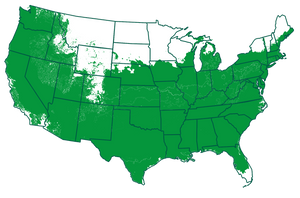* Images shown are of mature plants

Have questions? Talk with our Plant Experts (800) 973-8959
Save 25% on $200+ with code FALL25.
Questions? Call our plant experts: (800) 973-8959
Clusters of Small, White Flowers Bloom in Early Fall
Just like its name, the Sweet Autumn Clematis offers a lovely, light scent in late summer to fall as it blooms. This fast-growing plant is a climber, making it ideal for any yard that needs some added height or texture.
This Clematis features small, snowy white flowers in clusters against a backdrop of green foliage, creating a stunning display. Watch as your yard overflows with these tiny blooms from early fall to the first frost of the season.
Additionally, this plant works well as a groundcover in shady spots, but it also thrives in sunny areas. Prune it back to contain its height or growth, or let it expand to create your own pollinator garden, attracting bees and butterflies!
The vigorous, long-blooming Sweet Autumn Clematis is a must for any green space. Buy yours now!
Planting & Care
1. Planting: Clematis vines thrive with at least 6 hours of sunlight each day and benefit from afternoon shade in southern regions. They prefer cooler roots, so use mulch or plant shallow-rooted perennials nearby.
These plants grow best in rich, well-drained soil with a neutral pH, so check the soil's pH and add lime if needed. When planting, dig a generous hole, amend the soil as necessary, and avoid fresh manure.
Plant the crown 3–4 inches below the soil surface to protect dormant buds for new growth. Provide support immediately after planting to help the vines flourish.
2. Watering: It is important to water regularly, particularly during dry seasons. Because clematis has deep roots, ensure thorough watering.
3. Fertilizing: Clematis is a heavy feeder, so it's important to provide the right nutrients. In the spring, when the buds are about 2 inches long, apply a low nitrogen fertilizer, such as a 5-10-10 formulation. After that, alternate your feedings every 4 to 6 weeks with a balanced 10-10-10 fertilizer. Continue this alternating feeding schedule until the end of the growing season.
4. Pruning: Remove dead or damaged stems anytime. In the first spring after planting, prune all Clematis varieties to the lowest pair of healthy buds. Afterward, trim to control size and encourage blooms, and thin congested plants after flowering. For rejuvenation, cut the entire plant back to within 12 inches of the ground after flowering every three to four years.
Related Resources
Video: How to Build and Plant a DIY Arbor
An arbor is the perfect way to add interest to a large landscape area. And they look even better when they're covered in graceful, draping ...
Read the full article
Guide to Perennial Planting & Care
Springtime is for planting new varieties and giving your landscape a lift! With all the plants available out there, navigating them can get a little ...
Read the full article
How to Plant a Pollinator Garden?
Pollinators, such as butterflies, birds, moths, and bees, play a crucial role in our ecosystem — they help thousands of flowering plants to reproduce. In ...
Read the full article
Shipping Details
Estimated Shipping Time: Most orders ship immediately. As noted on the website, some items are seasonal, and may only ship in spring or fall. Once your order is shipped, you'll receive an email with a tracking number.
| Amount of Order | Shipping Charge |
|---|---|
| Less than $49 | $19.95 |
| $49 + | FREE SHIPPING! |
Product Details
| Mature Height: | 30 ft. |
| Sunlight: | Full-Partial Sun |
| Growth Rate: | Fast Growing |
| Botanical Name: | Clematis Paniculata |
| Does Not Ship To: | AK, AZ, HI |
| Grows Well In Zones: | 5-9 outdoors |
| Your Growing Zone: | # |





